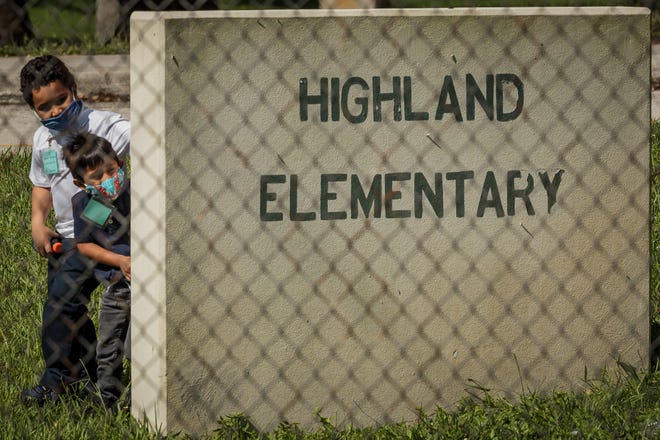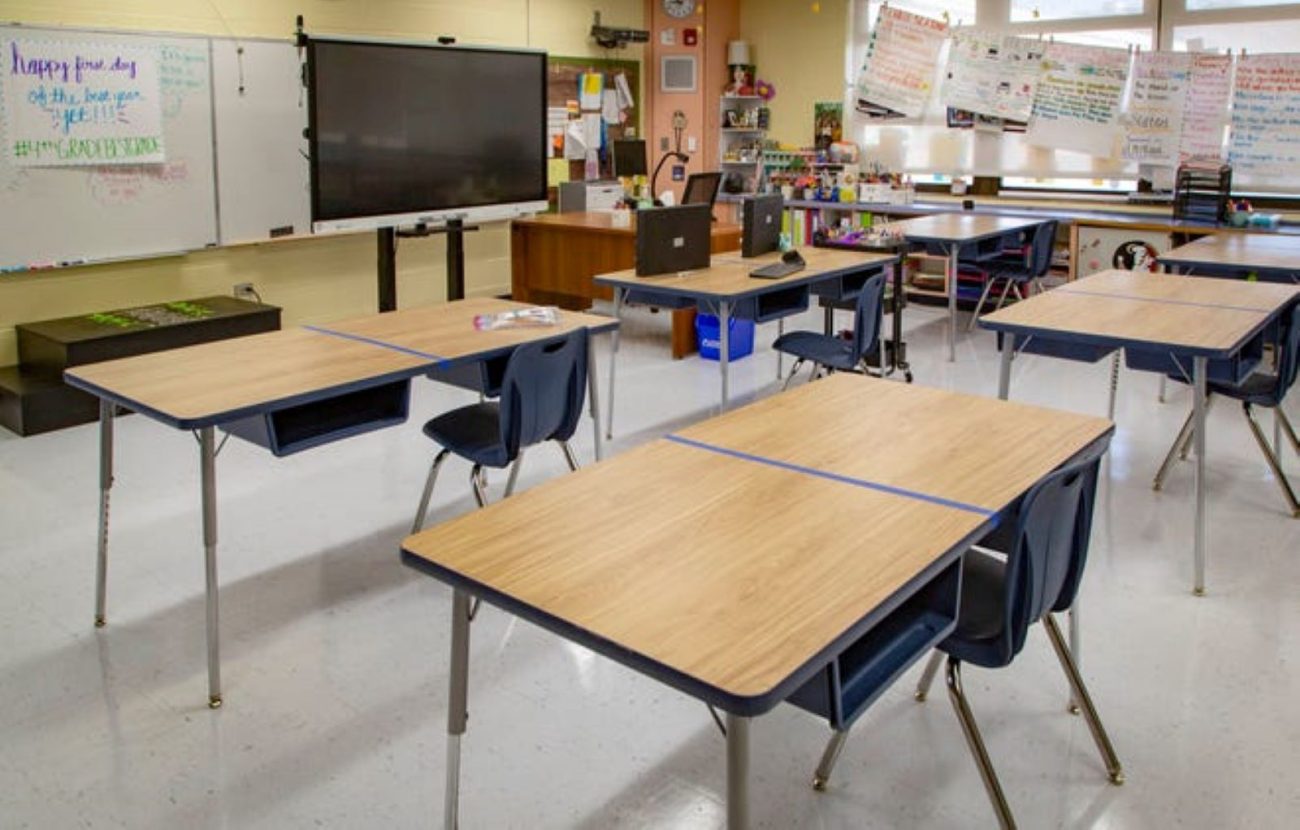Schools follow to the letter keeping kids 6 feet apart in classrooms, but that could change
The Palm Beach Post | by Sonja Isger | October 14, 2020
With about one-third of Palm Beach County public school students reporting to campuses regularly, only three classrooms districtwide are currently out of whack when it comes to seating all students at least 6 feet apart — down from a couple dozen classrooms when schools first opened.
Getting there took walking each campus, counting each desk — and in several cases rearranging the furniture, said Deputy Superintendent Keith Oswald, who consults an internal dashboard daily to check on those capacities.
While a number of the county’s schools, particularly decades-old elementaries, could hold every one of their students should all choose to return, according to the district’s calculations, many more could not — at least not and still maintain 6 feet of ground between each student.
That troubles many, including president of the Classroom Teachers Association, Justin Katz.
The seating at schools appears manageable for now. More problematic is the collapse of distancing going on in the corridors and lunchrooms on certain campuses, he said. “There are definitely schools where these situations are unmanageable.”
But, he said, “Our greatest concern is when more students return; that for us would inevitably lead to shrinking social distancing protocols and then all of the safety is thrown out the window.”
How much crowding will the district have to contend with going forward? Administrators say they hoped to have a more precise picture after Wednesday.
Parents were required to commit to in-person or virtual learning for the next academic quarter by day’s end.
To date, roughly 60,000 of the 170,000 students enrolled in Palm Beach County public schools are showing up in person, but attendance varies significantly from campus to campus. It also fluctuates daily on each campus, as students report in person one day and attend from their laptops on others.
Though the county’s reopening began with talks about the flexibility to push students as close as 3 feet — a distance that the American Academy of Pediatrics supports in schools when paired with mask wearing and hand washing — board members and medical professionals subsequently doubled down on the importance of maintaining the preferred 6 feet.

When a student at a Boca Raton area high school got COVID-19, school board Chairman Frank Barbieri went as far as to credit the seating arrangement for preventing the quarantine of the student’s classmates.
Oswald says that the district is being very deliberate about adhering to the 6-foot limit. He said he believes principals and teachers are getting better at finding strategies to keep students seated at that distance.
His dashboard tracks every classroom in the district — thousands of them. Populated by administrators who Oswald says have walked each room, the spreadsheet notes square footage, maximum capacities at 6-foot and 3-foot spacing, current enrollment and in-person attendance.
“I’ve been checking every day. We’re being very cautious,” Oswald said. “If 100 percent came back, that would be challenging.”
At a handful of schools, just a few more students will test administrators’ creativity.
Shuffling the furniture will get you only so far.
Planning beyond that requires that administrators know how many students will be on their campuses. If they know students are coming back, they can tell what that will look like.
On the other side of the equation, parents must choose one mode of learning for their children or another. But it’s not a straightforward choice.
For many, it’s a circular one: Tell me how many other children will be in that classroom, and I’ll tell you how comfortable I am sending my child. Or, tell me what school looks like, and I’ll tell you if they’re coming back.

No one wants to decide until everyone else has decided, concedes Pete Licata, regional superintendent of the district’s southernmost schools.
In the typical year, the county’s public schools have capacity for about 200,000 students, or about 30,000 above enrollment. But crowding has always been an issue of geography, with schools in some regions packed tightly and others with room to spare.
Now in the time of COVID-19, when health authorities prize 6 feet of distance between students, capacity everywhere has shrunk. And the first to feel it are schools where the fit was already tight, in the most affluent swaths of the county.
Calculating how many can squeeze into a campus is challenging math.
In the late 1990s, and propelled further by the 2002 class size amendment that limited the number of children in a room, the state’s building specs for a classroom have shrunk. In recent decades, the state has chipped away dozens of square feet from classroom footprints, said one-time district administrator and schools lobbyist Vern Pickup-Crawford.
At the same time, the amendment capped the number of students to 18 in the earliest grades, 22 in fourth through eighth grades and 25 in high school.
In the pandemic’s wake, more than one elementary principal has declared relief that their school was built before the amendment, when a typical elementary room, depending on grade, could spread out over 950 to 1,100 square feet.
With that kind of room, a school like Heritage Elementary in Greenacres, for example, can comfortably fit all of its students with at least 19 in a room and up to 22 students in the largest spaces, principal Nina Lant reported earlier this year.
But in general, the more modern elementary classroom of about 860 square feet can handle about 15 students, Oswald says. In high schools, where configurations vary — from large music rooms to intimate computer labs — 18 to 20 students can fit in a room 900 to 1,000 square feet.
The measurements are from student to student, not desk to desk. Some of the most immediate fixes that Oswald saw included starting desk rows against a wall or counter, eliminating unnecessary aisle space. Other successes came by switching from desks designed for two students to those meant for only one. In some classes, all of the desks remained but seating was spaced with an X to mark where students should not be, he said.
Also in the mix: overflow rooms, where students attend a class virtually from somewhere else on campus.
“Every case is different. You can’t cookie cutter it. That’s why we had principals walk every room,” Licata said. “Most campuses have additional rooms or additional spaces. If 25 kids come back for an AP class, then we move to a bigger room. Principals can do it, they’re happy to. But they need to know how many kids are coming back. Someone has to go first.”
Over time, barring a surge, it appears more students are destined to return to classrooms. As has been the case across the state after schools opened, the numbers have been steadily rising in Palm Beach County.
In Hillsborough County, where schools opened their doors about a month before they did here, there’s already talk of a waiting list as more students seek a return to campus.
One of the most critical area campuses right now? Addison Mizner Elementary‘s temporary campus in Boca Raton,which is nearing its capacity with only half the students on campus.
The school’s home campus, with buildings dating to 1946, has been leveled and students are spending the year on a campus of temporary classrooms parked behind Don Estridge Middle School while a new Addison is built. The elbow room that most schools have is not available at the makeshift campus.
With about 800 students enrolled but only half attending in person, the school has been able to maintain the recommended spacing, said Principal Joshua Davidow. And, he notes, the set-up has its bonuses, including open air walkways and individual air conditioning units.
Last week, the school brought in a dumpster to encourage teachers to haul any extraneous items out of their classrooms. Volunteers offered to come in and scan valuable paperwork so it could be stored electronically, Davidow said.
But if all 800 wanted to come back? “I would have to get creative,” he said.
Oswald says that creativity is likely to involve borrowing large indoor spaces from the school police training center next door — enough room to house an entire grade if need be.





